Boletus L.
Recent molecular studies have shown that Boletus in its current circumscription is likely an artificial grouping and it is possible that it will be split at some point into smaller genera. Note that Boletus impolitus and Boletus depilatus for practical reasons are retained here, although there is strong evidence that they are closely related to Xerocomus subtomentosus and its allies.
Fruitbody large to medium sized, boletoid, without veil and ring. Stipe solid, with surface usually covered with granules or network. Flesh variously coloured, changing or not when exposed to air. Tubes easily separable from each other, not tearing apart. Pores usually small and rounded.
Boletus spretus Bertèa
Description
Fruitbodies often clustered. Pileus up to 15 cm, at first hemispherical, then convex, flat-convex to flat, dry, usually velvety, but sometimes smooth when old, pale red, red, dark dull red, reddish vinaceous, darkening when bruised, cap margin often wavy. Stipe stout, cylindrical, club-shaped or swollen, cream or pale yellow to yellow, often reddish spotted in the lower part, covered with orange red, red or vinaceous granules, blueing or blackening when bruised. Flesh pale lemon yellow in the stipe, cream in the cap, blueing when exposed to air. Tubes pale yellow to yellow with olivaceous tint, bluieng when injured. Pores concolorous with the tubes, blueing or blackening when bruised. Smell mostly not distinctive, a bit earthy. Taste slightly acid. Spores 9.5–13 × 3–4.5 μm, ratio 2.7–3.6. Pileipellis (the cap cuticle) a trichodermium, composed of hyphae of cylindrical, finely encrusted cells.
Habitat. Warm broadleaf forests, mycorrhizal with oaks (Quercus) or sweet chestnut (Castanea sativa).
Distribution. Apparently southern, so far not seen outside of the Mediterranean area. Known from Greece, France, Italy, Spain and some Mediterranean islands – Corsica, Mallorca and Sardinia.
Similarity. Similar to the poorly known Boletus adonis which has broadly ellipsoid spores. Compare also to Boletus fragrans.
Notes. Some authorities use the name Boletus emilei Barbier.
Photographs
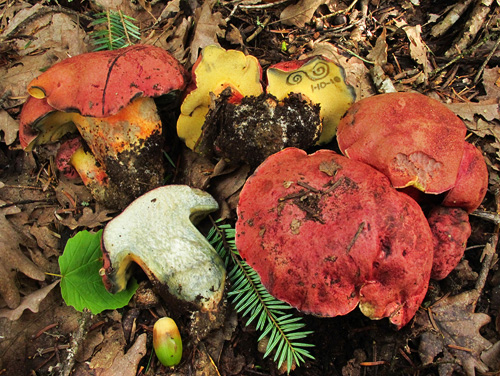
Fruitbodies of Boletus spretus. Note the darkening of the cap surface and the pores, as well as the faint blueing of the flesh. (photo G. Konstantinidis)
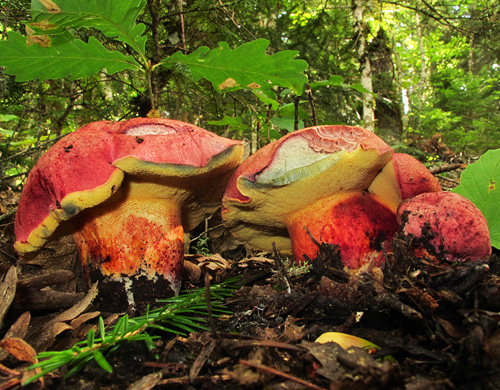
Fruitbodies of Boletus spretus. The colouration of the stipe is very typical. (photo G. Konstantinidis)
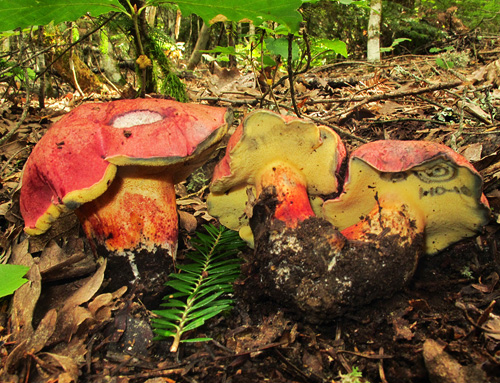
Fruitbodies of Boletus spretus. The irregular wavy margin of the pileus is very often seen in this species. (photo G. Konstantinidis)
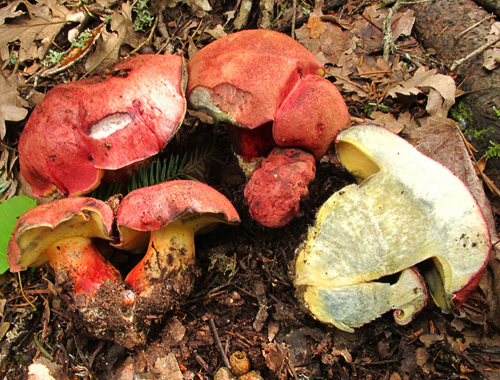
Fruitbodies of Boletus spretus. (photo G. Konstantinidis)

Old fruitbodies of Boletus spretus. (photo N. Amalfi)
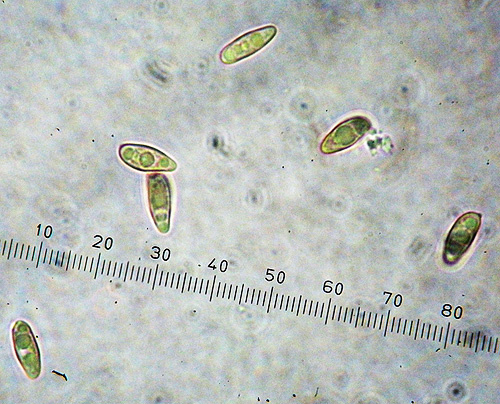
Spores of Boletus spretus. (photo G. Konstantinidis)
Important literature
Alessio, C.L. 1985. Boletus Dill. ex L. (sensu lato). – In: Fungi Europaei. Vol. 2. Pp. 1–705. Libreria editrice Biella Giovanna, Saronno.
Bertèa, P. 1988. Boletus spretus sp. nov. – Documents Mycologique 18: 62.
Estadès, A. & Lannoy, G. 2004. Les bolets européens. – Bulletin Mycologique et Botanique Dauphiné-Savoie 44(3): 3–79.
Galli, R. 1998. I Boleti. Atlante pratico-monographico per la determinazione dei boleti. Edinatura, Milano.
Lannoy, G. & Estadès, A. 2001. Les Bolets. Flore mycologique d’Europe. Documents Mycologiques Mémoire Hors série no. 6. Pp. 1–163. Association d’Écologie et de Mycologie, Lille.
Muñoz, J.A. 2005. Boletus s. l. – In: Fungi Europaei. Vol. 1. Pp. 1–951. Edizioni Candusso, Alassio.
Šutara, J., Mikšík, M. & Janda, V. 2009. Hřibovité houby. Čeled’ Boletaceae a rody Gyrodon, Gyroporus, Boletinus a Suillus. Academia, Praha.
Κωνσταντινίδης, Γ. 2009. Μανιτάρια, φωτογραφικός οδηγός μανιταροσυλλέκτη. Αυτοέκδοση, Αθήνα. [Konstantinidis, G. 2009. Mushrooms, a photographic guide for collectors. Published by the author, Athens.]